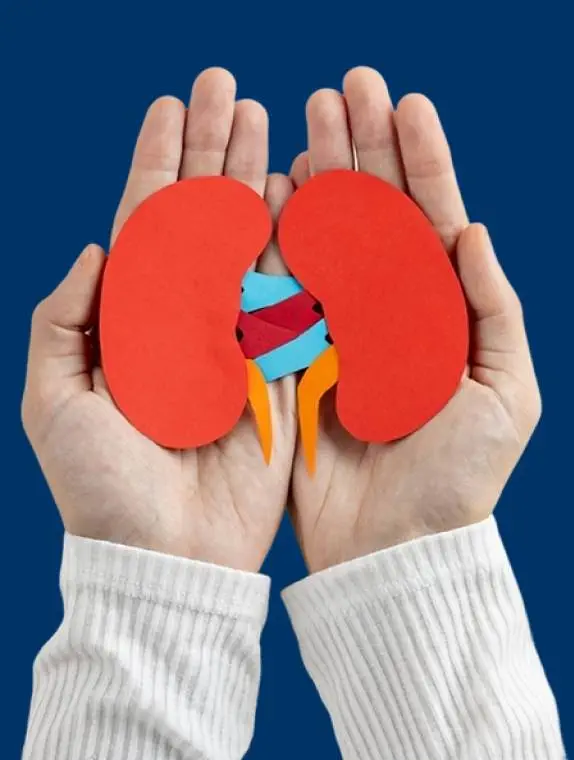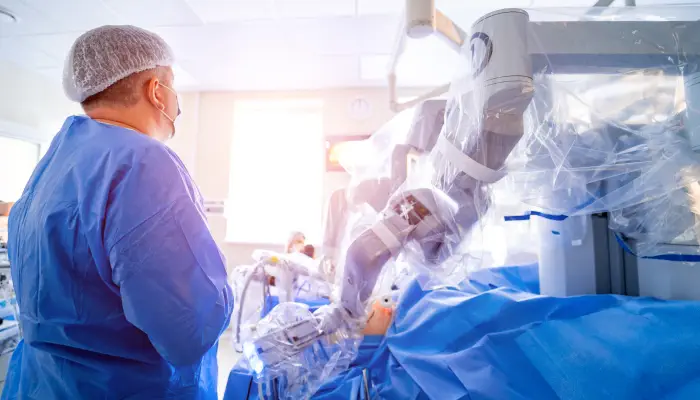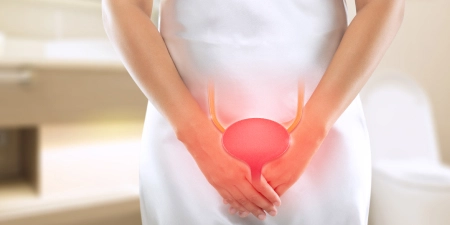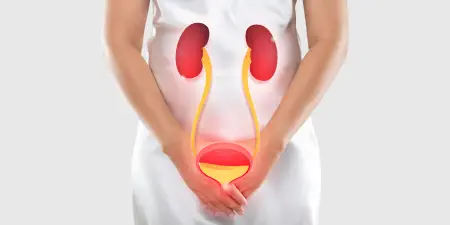Robotic Assisted Cystectomy

Robotic Cystectomy: Revolutionising Bladder Cancer Care
Robotic cystectomy surgery is a highly specialised procedure tailored for individuals with bladder cancer, especially when the disease has advanced and spread to the muscle wall. However, bladder cancer can be a challenging diagnosis, and many individuals may require surgery to remove either part of the bladder or the entire organ.
This procedure, known as cystectomy, is where our skilled robotic urologist, Dr. Aarthy P shines. Her immense understanding of robotic techniques helps significantly improve patient recovery times and overall outcomes.
Unlike open cystectomy, which requires a large incision, this robotic approach uses smaller incisions that take less time to heal and cause minimal pain. Dr. Aarthy is dedicated to leveraging her advanced robotic surgery knowledge to provide effective treatment and enhance patient outcomes. She is one of Chennai’s most sought-after uro surgeons for her expertise in this advanced medical approach.
Feel confident on your journey to recovery with Dr. Aarthy’s compassionate, personalised, and cutting-edge treatments.
When is Robotic Cystectomy the Right Choice?
Apart from cancerous and non-cancerous conditions, Robotic cystectomy surgery is a preferred modality for many other urological conditions:
Curing Bladder Cancer with Robotic Cystectomy

- Before Surgery
- What to Expect?
- Post-Surgical Care
What to Expect Before The Robotic Cystectomy Surgery
Dr. Aarthy will update you on several key steps to facilitate a smooth procedure and achieve the best possible results. Here’s what you should anticipate:
Thorough physical examination to assess your medical history and understand the extent of the cancer and its overall health.
Comprehensive blood tests, chest X-ray, Echocardiogram, ECG, biopsy, cystoscopy and other imaging tests like CT, PET, and MRI scan for further evaluation.
Examination of your family’s medical background, particularly concerning the risks associated with anaesthesia.
Discussion of your current medication intake and cessation of certain medicines like blood thinners before your surgery appointment.
Restriction of food intake for at least 6-8 hours before surgery to minimise adverse effects of anaesthesia.
Hospitalisation at least a day prior to your appointment. Dr. Aarthy will use this time to run tests and administer the preliminary medication for surgery.
What to Expect During The Robotic-Assisted Cystectomy
During this innovative procedure, your surgeon will manoeuver precision surgical instruments with the help of a robotic console. The process unfolds through a series of meticulous steps such as:
Tiny incisions are made in the abdominal region to facilitate the entry of robotic tools and a laparoscopic camera to view the surgical site.
The abdomen is inflated to allow for more space, and the internal view is displayed on screens for better visualisation.
The cancerous tissues from the lymph nodes, bladder, and adjacent areas are removed with robotically controlled instruments with great precision.
The robotic system allows for exceptional accuracy, reducing the risk of complications and improving recovery time after surgery.
Depending on the condition, your surgeon may reconstruct the urinary tract using robotic or traditional techniques. The following options may be considered for urine drainage:
Ileal Conduit
A small portion of the ileum (part of the small intestine) is used to create a stoma. A plastic ostomy bag is then placed over the stoma to collect urine.
Continent Cutaneous Diversion
Sections of the small and large intestines are used to create a continent reservoir to hold urine. A stoma is created for intermittent catheterisation, allowing the reservoir to be emptied without the need for an external bag.
Neobladder
A piece of the intestine is fashioned into a new bladder, which is then connected to the urethra. This allows the patient to urinate in a similar manner as before surgery, using the pelvic and abdominal muscles to empty the reservoir.
Robotic Cystectomy: Post-Surgical Care
As for any surgical process, recovery from robotic cystectomy is a gradual process that requires adequate care and adherence to your doctor’s guidelines.
After your surgery, you will be moved to a recovery room where your vital signs will be closely monitored until they stabilise. Once your condition is stable and Dr Aarthy confirms no post-surgical complications, you will be transferred to a regular room.
Keep your incision site clean and dry at all times. Follow your doctor’s specific instructions regarding bathing, dressing changes, and overall wound care. During follow-up visits, inquire about suture removal or any additional care required.
Mild discomfort and pain are common during recovery. To manage this, follow your doctor’s prescribed pain medication regimen. If you experience severe or unmanageable pain, reach out to Dr Aarthy for further advice or adjustments.
Look for signs of fever, chills, nausea, vomiting, heavy bleeding from the incision site, difficulty urinating, or uncontrolled pain. If you experience any of these symptoms, contact Dr Aarthy immediately.
For a few weeks following your surgery, avoid lifting heavy objects and engaging in strenuous activities. Always seek your doctor’s advice before resuming specific routine activities to ensure a safe recovery.
Benefits of Undergoing Robotic Cystectomy

Greater Precision
Superior visualisation of a significant range of motion allows surgeons to perform intricate procedures more accurately, leading to more favourable patient outcomes.
Less Pain & Blood Loss
Significant reduction in loss of blood and post-operative pain. This minimises the discomfort, requires less pain medication, and allows a more comfortable recovery experience.
Speedy Recovery
Shorter hospital stays, faster recovery periods, and smoother return to routine activities within three weeks after the procedure. This expedited recovery minimises the physical trauma and enhances patient comfort.
Minimal Scarring
Minimal, less noticeable scarring than those of traditional surgeries. This improves the cosmetic appearance of the surgical site, promotes quicker healing, and minimises patient recovery time.
Success Rate
Favourable success rate, compared to traditional open surgery. The precision allows for minimum risk of post-surgical complications, streamlined recovery, and quicker return to daily activities.
Commence Your Healing Journey







